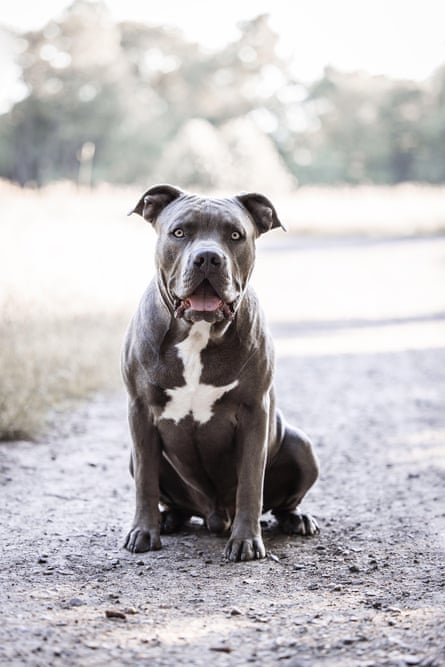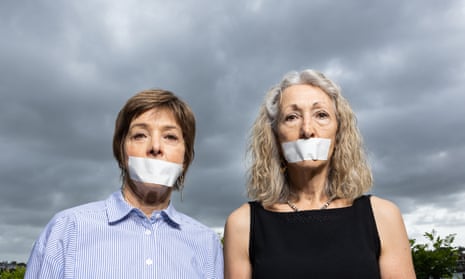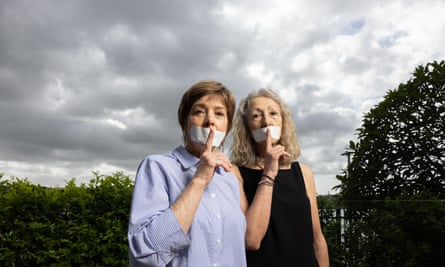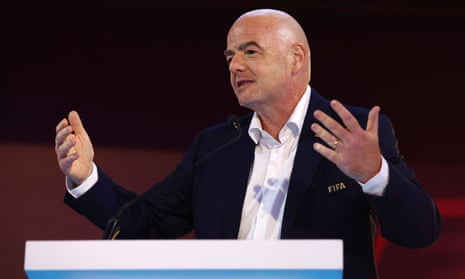In a normal year there are around three fatalities from dog attacks; this year there have been nine. What has happened – and can anything be done?

Emine Saner
@eminesaner
On a normal morning on a normal walk to school in Ramsgate, east Kent, Sophie and her three children saw their neighbour and his dog on the street and stopped to chat. “The kids pet the dog, everything’s normally fine,” she says. “And it all seemed fine the day it happened – there were no warning signs. I said: ‘Right, come on, we’ve got to get to school because we’re going to end up being late.’” Her seven-year-old son, Louis, gave the dog – a St Bernard and Japanese akita cross – one last stroke on its back, then the dog turned around, sank its jaws into his face and pinned him to the floor.
She and the owner grabbed the dog. Her other two children ran off in panic, a man came running out of a nearby business with a first-aid kit thinking there had been a car accident because of all the screaming, and Sophie held her son’s face to her chest to try to stop the bleeding. A paramedic car arrived and took Louis to a nearby park, from where he was airlifted to hospital, and into surgery. The dog, says Sophie, “had punctured straight through his top lip, and through his gums. It went through one side of his nostril.” On the other side, Louis had a 5cm laceration along his jaw. “The surgeon said if the dog had got him a little lower, we would have lost him. It was right next to his jugular.” Louis’s skin was pieced back together, and has healed well, says Sophie, although there is scarring. “It’s a constant reminder whenever you look at him.”
The number of injuries from dog bites has been increasing. Between 1998 and 2018, hospital admissions for dog-related injuries doubled in England, with about 8,000 people admitted each year. At Alder Hey children’s hospital in Liverpool, the number of children attending A&E for dog bites tripled during the first Covid lockdown.
More alarmingly, this year will be the worst for dog-related deaths. There are believed to have been nine people killed by dogs this year in England and Wales. In January, John William Jones, 68, died after being bitten by dogs at a house in Ceredigion, west Wales. Two months later, Kyra King, a three-month-old baby, died from her injuries following an attack by her family’s husky in Lincolnshire; her parents appeared in court last month. Just over two weeks later, 17-month-old Bella-Rae Birch died after being attacked at home in Merseyside by a dog that had just joined their family. A week after that, a two-year-old boy, Lawson Bond, died after an attack in Worcestershire by three dogs. After Joanne Robinson, 43, was killed by her dog at home in Rotherham in July, her mother reported that she had warned Robinson to get rid of him because he had started fighting with her other dog.
Between 2001 and 2021, the average was 3.3 dog-related deaths a year. It is still too early to tell whether this year marks something new or is a terrible anomaly (as well as a tragedy for the families involved), says John Tulloch, a vet and epidemiologist at the University of Liverpool, who researches dog-related injuries and deaths. What is clear, though, is that this isn’t because there are more dogs now.
Dog ownership soared during the pandemic, by about 10% to an estimated more than 10m, but dog-related injuries were rising even before that, when ownership was relatively stable. “There are relatively more bites per dog than there used to be, so it can’t solely be to do with the fact that we’ve got more dogs in the country,” says Tulloch. Dogs are biting more, and nobody knows why.
Tulloch says he was “quite surprised by the extent of it, for it to have gone up as much as it did, but also in the demographics”. Among those bitten by dogs, children have always been at higher levels, but this hasn’t really changed over the 20-year period Tulloch looked at. “The main growth in dog bites was to adults – that was something that we were not expecting, and we still don’t really know why that’s occurred.”
There are several theories to the overall rise. “It could be to do with how we’re sourcing dogs,” says Tulloch. “We know that with young puppies, if they’re not socialised in the right way, and they don’t come from a good background, then there’s the potential that they could have behavioural issues when they’re older.” With online advertising, it is easy to get a dog, and high prices may have led to unscrupulous breeders. “It could be that more people are buying puppies of unknown backgrounds that haven’t been socialised or looked after very well when they’re little.”
Before the pandemic, it was becoming clear that many owners weren’t looking after their dogs correctly – not something that is likely to have improved now that many new dog owners are expected to be back in the office. “Over half of UK dogs weren’t meeting their daily exercise requirements and around about a quarter were spending more than five hours alone at home every day,” says Tulloch. “That could lead to dogs getting frustrated.”
Another theory, he says, is that people are not good at “reading” dogs, and that social media has encouraged people to view them as happy when dog experts would read the animal’s body language as the opposite. “I do think the way you see people interacting with dogs on social media is very different to what was occurring, say, 20 or 30 years ago,” says Tulloch, although he acknowledges that social media may simply have made it more visible. A video showing a dog “smiling” might get rewarded with a lot of likes and shares. “But that dog isn’t smiling – it’s showing its teeth, and that’s a sign that it’s stressed and uncomfortable, so the potential that that dog could then go on to bite is greater.” He has seen shared videos of very small children or babies with dogs, “and in a lot of those videos, the dog is almost frozen in that scenario – that’s another classic sign that the dog is uncomfortable”.

Carri Westgarth, senior lecturer in human-animal interaction at the University of Liverpool and author of The Happy Dog Owner, says there are early signs that might tell us a dog is feeling overwhelmed or threatened before it gets to biting point. These include, she says, “excessive licking, excessive yawning, turning their head away, raising a paw, showing the whites of their eyes, and rolling over and showing their belly”. A dog will usually try to get away from a situation rather than bite, she says. “The problem is, these signals get ignored and the dog may be chased or trapped when trying to move away. Therefore they escalate to freezing, growling, snapping or biting.” Another issue is when a dog has learned that these early signs get ignored by their human, “and then just go for the snap, out of the blue. Bites also often occur whilst playing or frustrated, so make sure not to wind dogs up too much.” She advises reading books and watching videos on YouTube on dogs’ body language.
We also probably expect more from our dogs than ever before, she says. “It’s a busy, stressful world even for us, and we expect our dogs to come everywhere with us, and cope with all the places and people. Unless dogs have been bred from parents with nice and confident temperaments, and are well-socialised and trained when they are young, they may struggle to cope when they are older. This is why there are concerns about ‘pandemic puppies’ who could not be socialised at the time and, due to demand, many likely came from poor breeding environments.” The familiar saying “there’s no such thing as a bad dog, just a bad owner” isn’t helpful or true, says Westgarth. “As an owner we can try to do all the ‘right’ things”, but the dog’s genetics and early experiences are beyond our control.
If a dog does bite, Westgarth says “some sort of shock can startle them enough to let go, such as shouting, a loud noise or pouring a lot of water on them suddenly. Then try to put a barrier between you and the dog.” If a dog is attached, try not to pull yourself away – easier said than done in the moment, she acknowledges – “but stay still so that it is less likely to tear the flesh. However, most bites are quick and last a second, if that. A dog consistently attacking or not letting go is less likely, depending on the breed and the reason for attack. Then secure the dog in a safe place as soon as you can.”
The bite to her hand that Deborah received this summer was so fast, she didn’t realise the dog had bitten her. She was passing a young woman and a lurcher on the pavement in a village in Derbyshire. “I don’t actually recall the dog jumping at me; I just suddenly felt this pain in my hand, and all this blood coming out.” The owner, she says, “seemed more upset than I was. I think I was in shock.” She remembers the dog sitting very obediently by its owner, but it was shaking. Deborah went to A&E and now has a three-inch scar across her hand. “I’ve got very little feeling in my right thumb, and the back of the hand where the scar is, there’s no feeling there. The skin is very tight.”
The police came to see her a couple of weeks later and told her that the dog would be muzzled and the owner and dog would be going for training. “I didn’t want it put to sleep,” says Deborah. “Unless it’s got previous [history of biting], I wouldn’t want a healthy animal put to sleep. A lot of people said to me: ‘You need to get the dog put down’, because where my hand was is the height of a child’s face. If it had been a child, it would have been a completely different story.” The experience, she says, “has shaken my confidence. If I see a dog coming, I do try and avoid it if I possibly can. Not to the extent of crossing the road, but certainly moving out of the way, and not trying to make any sort of move.”
Most bites – more than 80% – occur at home, by a dog known to the victim. “That’s one of the difficulties – a lot of what’s going on is happening behind closed doors, so to try and understand exactly what was preceding the bite is difficult,” says Tulloch. It also means the true figure for dog bites is likely to be far higher than the hospital admissions we know about. “Below that, you’ve got A&E and minor injury unit attendance, and we don’t know that figure. And then there’s going to be a whole bunch of other people that have been bitten by dogs that will treat themselves.”

A general lack of data – about true figures for injuries, and about demographics of owners or breeds – means it is impossible to get a good picture, or to know what to do about it. Of the nine deaths this year, six involved a breed known as an American XL bully, a large muscular breed originating in the American pit bull terrier, but Tulloch says we don’t have the evidence to say it’s a dangerous breed. (In the UK, only four breeds are banned under the Dangerous Dogs Act, including pit bull terriers, though the idea of banning breeds in itself is controversial.) “With the hospital records, we don’t have any [breed] information. On top of that, we don’t know what the makeup of the dog population is in the UK so, with XL bullies, we’ve got no idea how many there are in the country. If we look at other countries where work has been done on that, no country has found that one breed of dog is more likely to cause bites than others.” A bigger breed can potentially do more damage, he says, “but fundamentally, any dog can bite”.
There are things that could help, such as educating owners about dog body language, as would “simple steps, like getting the message across to never leave a child alone with the dog because children are a lot more vulnerable to severe injury”. He would like to see more control over how and where people can purchase dogs, and have a central microchip database (all dogs have to be microchipped by the age of eight weeks, but private microchip companies keep their records). “Even just having an understanding of the dog population, so that we can say: ‘This area has a high number of dogs; does it have a high number of bites? Or is there something else going on there that we don’t know about yet?’” An earlier study found hospital admissions from dog bites were three times as likely in deprived areas of the country. In Merseyside, which has the highest number of dog attacks, the Merseyside Dog Safety Partnership has been formed, bringing together the University of Liverpool researchers with others, including the police, NHS and dog charities to research behaviour and prevent injuries.
The UK used to have a dog licence, abandoned in 1987, and Tulloch isn’t necessarily keen on a return. “If it’s just paying an amount of money to say you have the dog and nothing else happens, I’m not sure what difference that is going to make.” Angus Nurse, head of criminology and criminal justice at Nottingham Trent University agrees. “Licences don’t necessarily, by themselves, solve the problem. They don’t necessarily do anything about the behavioural issues.”
Nurse, previously at Middlesex University, led a study published in December 2021 into measures that might reduce dog attacks and promote responsible dog ownership. It was commissioned by the Department for the Environment, Food and Rural Affairs, which has established a working group to look at the recommendations; conclusions are expected next year. “We looked at a whole load of literature around dog attacks, held some focus groups, spoke to veterinary professionals, police officers, enforcers in local authorities, and animal behaviour specialists,” says Nurse. “The main thing that came back was that most of the attacks are probably preventable.”
Among the recommendations are the need for more and better data on dog attacks, to understand more about the dog and the context in which the incident happened, and more consistent dog-control enforcement. New requirements for owners could include having a “clean” dog-owning record (with no dog-related complaints against them) and proof they have a level of knowledge about care. Where there are control problems, or a dog has been involved in an attack, owners should go on training courses. “We spoke to colleagues in Holland, where this is already the case,” says Nurse. “The comparison that’s often made is with speed awareness courses we run for drivers who get caught speeding. If you have a dog, and the dog is out of control, it’s not just down to the dog – it’s down to how you relate to the dog.”
The research didn’t look at breeds, or the merits of the Dangerous Dogs Act. “Certainly in the literature, you’ll see some argue that breed is a factor, some that argue that breed is not a factor,” says Nurse. “Some pieces of research will argue that breed-specific legislation is not necessarily effective, because it doesn’t address the wider issue of dog problems.”
After Louis was bitten on the way to school, the owners of the dog decided to put it down. “It wasn’t necessarily the dog’s fault or the owner’s fault, and it certainly wasn’t my son’s fault – even before the attack he’d always ask an owner if he could stroke a dog. It’s just a crazy situation that you’re in at the time,” says Sophie. She says she covered every mirror in the house for six months. “He wouldn’t look at himself; he caught sight of himself the morning after the surgery and said: ‘Mummy, I look ugly. I don’t like it – take it all away.’” Louis and his siblings have had nightmares and have received counselling at school. All are wary of dogs, especially bigger ones, but the family have their own dog – a labrador and jack russell cross – and that has helped. “When he came home from hospital, our dog knew instantly that something was wrong and he was with my son the whole time. He didn’t move from his side.”


















